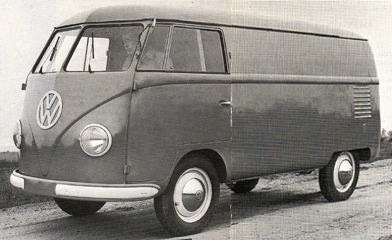
ABOVE,
an early 1950 panel van, note that there aren't any vents in the rear
cargo area. BELOW, one of the first Commercial VW sales brochures. This
one is from Belgium
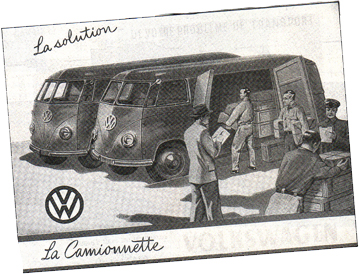
|
|
1950.
It's Official!
According to some factory records, production of the Volkswagen Commercial Type
2 began at Wolfsburg, in March of 1950. Other records put the date at April
18th. Perhaps they started production in march and finished the first vehicle
in April. Either way, 1950 is the first official production year.
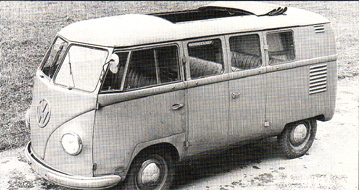 At
first production was very slow, only a few transporters a day. However, by the
end of the year they were making about 60 vehicles a day. The first model designed
was the panel van then the Kombi, Microbus, and ambulance were added to the
line. Each Kombi had three windows on each side of the cargo area while the
Microbus was a fancy version of the Kombi, with seats, panels, headliner and
a sliding partition to the storage area over the engine. VW's ambulance was
a modified Kombi and the only van with outside rear access to the cargo area.
The Volkswagen Transporter, following in the Beetle's footsteps, quickly became
a best-seller.
At
first production was very slow, only a few transporters a day. However, by the
end of the year they were making about 60 vehicles a day. The first model designed
was the panel van then the Kombi, Microbus, and ambulance were added to the
line. Each Kombi had three windows on each side of the cargo area while the
Microbus was a fancy version of the Kombi, with seats, panels, headliner and
a sliding partition to the storage area over the engine. VW's ambulance was
a modified Kombi and the only van with outside rear access to the cargo area.
The Volkswagen Transporter, following in the Beetle's footsteps, quickly became
a best-seller.
There were several changes in the 1950 production model, over the test versions. The fuel filler was moved inside the engine compartment and does not stick out the back as it did on the 1949 prototypes. Upper front door hinges were raised to the belt line. Engine lid prop was moved from the let to the right of the engine compartment opening, and the engine air intake vents were made horizontal instead of vertical, as they were on the prototypes.
Production models also got a windshield wiper for the passenger. Originally, there had been only one for the driver. The shape of the front bumper was changed and the raised portion of the production model is more rounded on the ends. They still didn't have a rear bumper or rear window and both the fron and back VW logos were still a heavy cast aluminum.
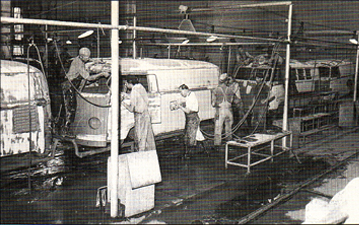 ABOVE, a rare shot of the 1950 assembly line. These guys are hand sanding the finished bodies in preparation for paint. BELOW, the fuel filler was moved inside the engine compartment, and on this early version, the spare tire is out of sight to the right. 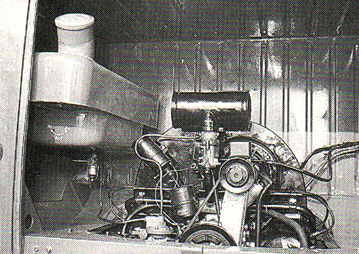 |
Because this vehicle was such a new design, changes were still being made during the production year. Most afficionados refer to the 1950 buses as either an "early" or a "late" model, even though it's known that all the changes weren't made on the same day.
On the early 1950 models, the front jack ports were several inches back from the reinforced post, located behind the front doors. They must have had to change a few front tires, on a few heavily loaded vans before they saw a few floors start to cave in. The front ports were then moved over a couple of incehs, under the stronger post. On the 1950 Type 2s, rain gutters are short. They started at the front corners of the roof section and run about two-thirds of the way back, stopping just behid where the last window is on the Kombi.
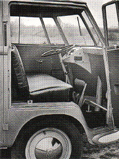 The driver's compartment of these new Type 2s was quite spartan. The one-piece front kick panel is unique to these first transporters. |
At the first of the year, as on the prototypes, the spare tire was stacked to the right of the engine compartment. By the end of the year, it layed into a rack over the top of the engine. On all the '55 and earlier "Barn Door" buses, except the ambulance, the only way into the cargo area was through the side doors. On the early 1950 models you had to remember your key. Handles were added to the late versions.
Another recognizable modification made during the 1950 model year was the addition of ventilation louvers in the upper back corner of panel vans. There wasn't any ventilation in the cargo area of the early '50 panels vans. Because most of these vans came with cab dividers, it got pretty stufy back there. These vents were added mid-year, but were only half the length of the engine vents.
The drivetrain remained basically the same as the final prototypes, a VW Bug 25hp, 1131cc engine and transaxle, run through reduction gear boxes on the end o the axles. Top speed was listed in the sales brochure as 75Km per hour. The electrical system was a 6-volt and you only got one gauge, a speedometer with a couple of "idiot lights." Tires were 5.50x16-inch.
About 8,100 transporters were built in 1950, but very few survive today.